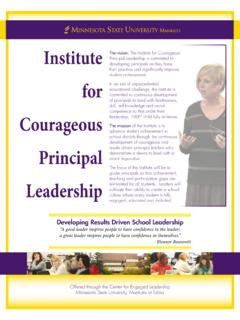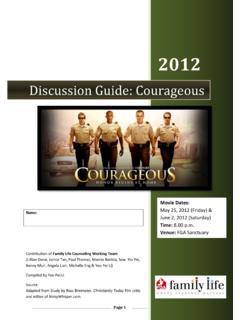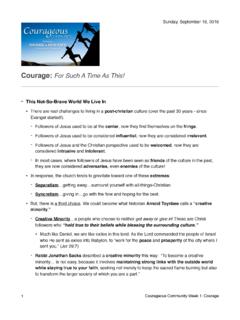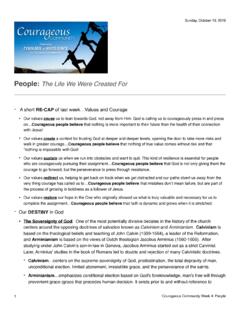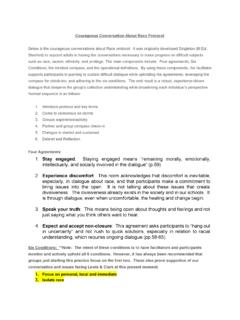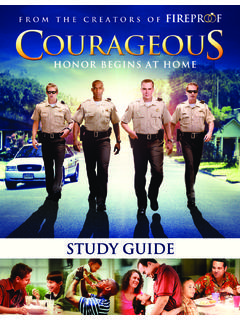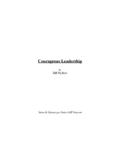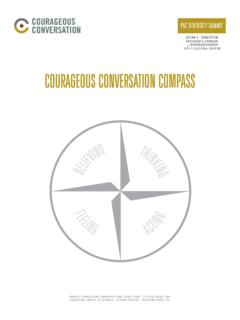Transcription of COURAGEOUS COMMUNICATION Peggy Smith, CNVC …
1 COURAGEOUS COMMUNICATIONa Nonviolent Communicaton Curriculum for theMaine Coastal Regional Reentry Center byPeggy smith , CNVC certified NVC TrainerO g This work is licensed under a Creative Commons Attribution-ShareAlike International License Dedication This document is dedicated to all the men I have had the pleasure of meeting during my time at Maine Coastal Regional Reentry particular, Alton Lane, who by Session 3 had embraced NEEDS-based consciousness, and now dedicates himself to the journey of the peaceful to my children - Mark, Missy, April and Gemma Laser. Each in their own way inspires me to love and keep my heart open to all that unending gratitude to my two root teachers:Thich Nhat Hanh, who guided me to my heart s strengthMarshall B.
2 Rosenberg, who shared with me how to let my heart find voiceA special thank you to Bonnie Fraser and Liv Larsson for their generosity and companionship, even though we have never met. I have great respect for their NVC NVC skills I have, I owe to my varied NVC teachers I endeavor to do their work justice and hold them dearly as friends along the path: Marshall B. Rosenberg, Gina Cenciose, Wes Taylor, Gregg Kendrick, Miki Kashtan, Sura Hart, Robert Gonzales, Susan Skye, Towe Widstrand, Dominic Barter, Rita Herzog. This document, and the web presence of the Maine NVC Network, would not exist without the dedication, love and skill of Betsy Terrell.
3 Betsy is a constant, talented NVC companion whose encouragement, editing skills and web talents make it possible to share this work with the wider community. My life is so much the richer for her varied : Background and Recommendations4 Session 1: Introduction to NVC7 Session 2: Exploring the Connection between Feelings and NEEDS13 Session 3: Deepening the Connection between Feelings and NEEDS16 Session 4: Revisiting the 4 Chairs 18 Session 5: Three Pieces of the Puzzle21 Session 6: Exploring Empathy23 Session 7: Feelings & NEEDS Poker25 Session 8: Requests27 Session 9: Using NVC to Influence My Life29 Session 10: Wrapping Up30 Resources3 2 List of HandoutsAll handouts were created by Peggy smith , unless otherwise noted on the handoutThe 4 Chairs Choosing My ThinkingFeelings and NEEDS ListsSomething Kind I DidSomething I Like / Don't LikeNEEDS SortChanging Our JudgmentsImportant RelationshipsEmpathyRequestsWho Am I?
4 Strategies to Nurture NEEDSS omething I Did That Hurt AnotherRequests That MatterMaine Coastal Regional Reentry Center NVC Curriculum : COURAGEOUS CommunicationIntroductionNote: This curriculum is intended for use by teachers and facilitators already fluent in NVC. The curriculum is organized into ten sessions, including the session overview and instructions and all handouts to be used during each session. Feelings and NEEDS cards, used frequently, can be downloaded for free, and printed (see Resources for source). Throughout the text, I have used plural pronouns as a strategy for gender Maine Coastal Regional Reentry Center (MCRRC) in Belfast, Maine, USA, is a residential reentry center designed to give incarcerated men the skills and experience they need to live successfully as positive citizens and employees after they transition back into their home communities.
5 The men are provided a variety of treatment, educational and vocational opportunities focused upon reducing recidivism. It is a joint venture between the Sheriff s Department and Volunteers of America. The Reentry Center serves Hancock, Knox, Lincoln, Sagadahoc, Waldo and Washington counties. The facility can house up to 32 adult males, all of whom are required to meet certain criteria to qualify. These qualifications include being within eighteen months of release and being at a moderate to high risk of the program began in 2010, a local NVC enthusiast, Michael Shell, suggested to the program director that NVC be added to the weekly educational offerings.
6 Michael pioneered the program for about six months. I agreed to take over when he left the area. Over the years I have crafted the curriculum that is shared in this document. Our NVC class structure is two hours a week for ten weeks. This has become a required course within the center s educational offerings. After three years, I changed the course title from Nonviolent COMMUNICATION to COURAGEOUS COMMUNICATION . The men sometimes resisted taking a course in nonviolent COMMUNICATION , because they said they were not violent, or they were not convicted for violent offenses. I was inspired by the work of Daryne Rockett, a clinical social worker at a Maine Veterans' Center who incorporates NVC and Mindfulness and calls her classes COURAGEOUS COMMUNICATION .
7 Indeed, it takes immense courage to take responsibility for our lives and to make choices that change engrained habits. We believe the NVC journey is indeed a journey of courage and Important PreparationsThis curriculum is intended to support to experienced NVC practitioners who would like to enrich work they are already doing with incarcerated people, or who want support/inspiration in starting such a program. This curriculum assumes the user has already done a good amount of integrating of needs-based consciousness 4into their personal life. In addition, I HIGHLY recommend that anyone using this material do the work presented in Liv Larsson s book, Anger, Guilt & Shame: Reclaiming Power and Choice as part of their own personal growth.
8 When we work with a vulnerable population, it is important that we have explored our own relationship to such intense emotions. This will support us as we work with people who are themselves in deep pain, and help us respond empathically and authentically to issues as they become alive within the class , please be sure to set up an empathy support system for yourself so that you can be nourished as you do this challenging and rewarding work. Putting It into ActionDuring the five plus years that I have offered Nonviolent COMMUNICATION classes at the Reentry Center, I ve concluded that the most important way to demonstrate the power of needs-based consciousness is to follow the energy in the room.
9 While I strive to do that in all my teaching, it is especially important when I work with incarcerated people . This is because people embedded in overt authoritarian structures have little opportunity to experience the consideration and nurturing of the following NEEDS: to be heard, to matter, acceptance, tenderness, understanding, support, honesty, honoring agreements, authenticity, empathy, choice, to be seen for one s true intentions, acknowledgment, power with, recognition, consideration, integrity, trust, fun and primary strategy to nurture these NEEDS in the course of our sessions is to use the opening check-in to listen for something "really alive" for an individual or the group.
10 So, while I come with a curriculum for the day, from Session 3 onward I consider that secondary to processing a real situation that may be expressed during check-in by one or more group instance, on one occasion a member shared that they were upset because the day before they had been informed that their custody rights had been terminated. Another day someone shared that some of their cigarettes were missing. Another time someone shared that during a weekend pass they had started a new love relationship. Another time the whole group was upset because of an interaction with a staff member at morning the whole check-in is complete, I cycle back to the person(s) who raised a hot topic and ask their permission to use it (or not) for a group learning.
